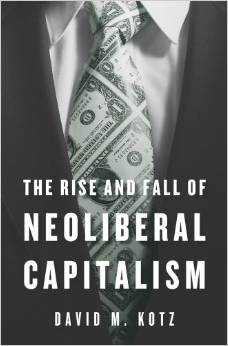Economic crisis is a structural crisis of neoliberal


Professor David Kotz and his book: The Rise And Fall of Neoliberal Capitalism
Since the financial crash of the 2008, the attention on the crisis and capitalism itself is constant. The ongoing crisis, its causes, its aftermath, the possible solution, all these have been debated for years, and yet a convincing diagnose has not been reached. In a coming book by David Kotz, The Rise and Fall of Neoliberal Capitalism (Harvard University Press, Feb. 2015), he argues that the economic crisis is a structural crisis of neoliberal, and that it requires major institutional restructuring.
David M. Kotz is Professor of Economics at the University of Massachusetts, Amherst, and Distinguished Professor, School of Economics, Shanghai University of Finance and Economics. He was one of the few academic economists to predict the crisis, argues that the ongoing economic crisis is not simply the aftermath of financial panic and an unusually severe recession but instead is a structural crisis of neoliberal, or free-market, capitalism. Consequently, continuing stagnation cannot be resolved by policy measures alone.
In the last decades of the 19th century in Europe, the competitive, small business, small government form of capitalism experienced an extended economic crisis, often called the Great Depression of the late nineteenth century. It was not resolved until giant corporations and banks transformed and stabilized the economy along with more interventionist governments around 1900, giving rise to monopoly capitalism. In the 1930s the monopoly capitalist form of capitalism produced the Great Depression, which was not resolved until the late 1940s when another new form of capitalism emerged, which can be called “regulated capitalism” based on capital-labor compromise, new forms of state regulation of companies and markets (including close regulation of the financial sector), a welfare state, and newly dominant Keynesian economic ideas. After several decades of rapid growth, regulated capitalism entered its crisis phase in the 1970s, as the profit rate fell rapidly in the US and Western Europe and inflation accelerated, unemployment rose, and the international monetary system of fixed exchange rates collapsed.
Kotz said, that crisis was resolved by the rise of neoliberal capitalism in the late 1970s to early 1980s. Neoliberal capitalism brought new institutions: the marginalization of collective bargaining, deregulation of business and markets including the financial sector, privatization of state enterprises and public services, and big cutbacks in social programs that benefitted workers, as well as a shift in the dominant economic ideas from Keynesian to free-market ideas. In addition, capital-labor compromise was replaced by full domination of capital over labor.
He pointed out, the neoliberal form of capitalism brought some 25 years of long economic expansions with moderate inflation, although economic growth was slower in this period than it had been under the previous regulated capitalism.
“In 2008 we saw not just a financial crisis and great recession but the beginning of the crisis phase of the neoliberal form of capitalism. The severe stagnation in many parts of the global capitalism cannot be replaced by normal capital accumulation without another round of major restructuring.” He said.
Kotz asserted, the ability of any form of capitalism to promote economic expansion does not last forever – after one or several decades it turns from a structure that promotes capital accumulation into one that becomes an obstacle to it. At that point, the system enters what is called a structural crisis—a period of relative stagnation and heightened instability. A structural crisis—unlike a normal business cycle recession —cannot be resolved by any automatic economic mechanism of capitalism nor by wise government policies alone. Its resolution requires the rise of new economic and political institutions, along with new dominant economic ideas, that will again promote accumulation.
In his new book, he discusses three possible directions of economic restructuring that could potentially lead to economic stable economic expansion again. He explained, all three involve an increased state role in the economy. One would be a statist, nationalist form of capitalism aimed at increasing military strength – that would not be favorable for working people or for the prospect of a peaceful world. A second would be another period of social democratic capitalism, with the gains of economic progress shared between labor and capital. The third possible direction of institutional change would go beyond capitalism, that is, a transition to socialism. He noted that none of these three possible structural resolutions of the current stagnation is visible today, but he expects such directions of change to emerge over the next five to ten years in the developed capitalist countries.
Chu Guofei is a CSST reporter based in Boston.
